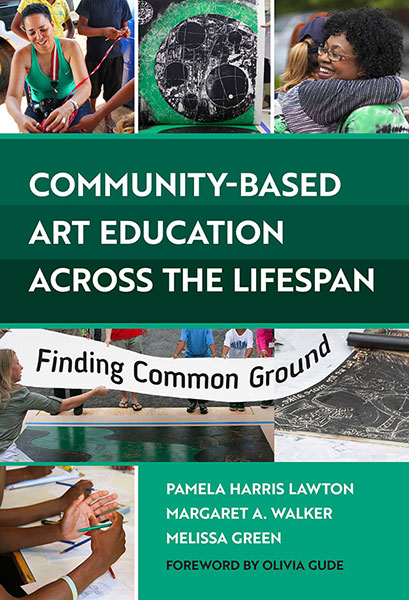Professors: Request an Exam Copy
Print copies available for US orders only. For orders outside the US, see our international distributors.
Pamela Harris Lawton, Margaret A. Walker, Melissa Green
Foreword by: Olivia Gude
Publication Date: July 19, 2019
Pages: 208

This book is a comprehensive introduction to the theory and practice of Community-Based Art Education (CBAE). CBAE encourages learners to make connections between their art education in a classroom setting and its application in the community beyond school, with demonstrable examples of how the arts impact responsible citizenship. Written by and for visual art educators, this resource offers guidance on how to thoughtfully and successfully execute CBAE in the pre-K–12 classroom and with adult learners, taking a broad view towards intergenerational art learning. Chapters include vignettes, exemplars of practice, curriculum examples that incorporate the National Coalition for Core Arts Standards, and research frameworks for developing, implementing, and assessing CBAE projects.
Community-Based Art Education Across the Lifespan will help artist-educators to:
Pamela Harris Lawton is a practicing artist and associate professor of art education at Virginia Commonwealth University. Margaret A. Walker is a clinical associate professor of art education at the University of Maryland, College Park, and coordinates the master’s programs in Visual Arts and Arts Integration in UMD’s College of Education. Melissa Green is a museum educator, artist, and creative community engagement designer.
“Much has been said recently about the need to foster inclusivity and to build bridges between schools and the communities that they serve. However, few resources are available to guide educators who wish to take action. Through sharing their broad experience with CBAE and walking the reader through the steps they have used to create successful projects, Lawton, Walker, and Green are able to fill this void. They explain how they were able to establish common ground with diverse stakeholders while also offering transformative experiences to students. Artists and teachers who desire to promote greater community engagement, either by working with K-12 schools or by serving older learners, will find this book an inspirational and useful roadmap.”
—Teachers College Record
“A thorough guide written in an accessible tone and filled with theoretically sound, pragmatic, (re)constructivist strategies.”
—Studies in Art Education
“The strength of this book is the broad range of information it offers for the researcher, K-16 art educators, community artists and non-profit organizations. It provides a road map for putting together a collaboration which can result in finding a community’s core strength and empowering people’s collective voice. This well documented research with multi-generational populations supports age-integrated arts learning curriculum and offers ways to making positive contributions by creating community and finding common ground.”
—International Journal of Lifelong Learning in Art Education
“I have been a teacher and community artist for over 40 years and I was fully engaged with this text. I found myself nodding in agreement, frowning in concentration as I considered a fresh perspective, or ironically smiling at pointed advice concerning making plans based on the reality of time constraints.”
—Olivia Gude, Angela Gregory Paterakis Professor and Chair of Art Education, School of the Art Institute of Chicago (SAIC)
“This is the book I have been waiting for—carefully researched, thought-provoking, and inspiring. It is for everyone who is concerned with enhancing social cohesion and understanding. It shows how we can bring diverse groups together to create, empathize with each other, and celebrate. This is what our fragmented society urgently needs.”
—Lily Yeh, award-winning artist and founding director of Barefoot Artists Inc.
" A practical guide for community-based art education that is theoretically grounded in social justice. Insightful suggestions for working with communities, planning, creating transformative learning, and evaluating outcomes are based in the authors' deep experience. This book is a timely and welcome volume that will be indispensable to individuals and community organizations working in the arts for positive change."
—Elizabeth Garber, professor emeritus, University of Arizona
Contents
Foreword Olivia Gude xi
Acknowledgments xiii
Introduction 1
What Is CBAE and Why Should We Get Involved? 2
A Brief History of Community-Based (Visual) Art Education 3
Summing Up, Looking Ahead 6
Part I: Planning CBAE Projects
1. Definitions, Frameworks, and Developmental Theories 9
Terms and Definitions 9
E.R.E.C.T.: Constructing a CBAE Conceptual Framework 11
CBAE and Psychosocial, Cognitive, and Artistic Development 12
CBAE and Creativity 21
Summing Up, Looking Ahead 25
2. CBAE, Educational Theories, and Research 26
Situated Learning and Legitimate Peripheral Participation 26
Experiential Learning 27
Transformative Learning 27
CBAE as Engaged Pedagogy/Andragogy 30
CBAE Research Paradigms 30
Summing Up, Looking Ahead 38
3. Getting Started: Locating Stakeholders and Communities 40
Why Community-Based? 40
Navigating Privilege 44
Getting Started 46
Summing Up, Looking Ahead 54
4. Planning the Project: Setting Goals and Learning Outcomes 56
Working Within Time Constraints 57
Developing a Budget 59
Setting Goals and Learning Outcomes: Scope and Sequence 59
Summing Up, Looking Ahead 65
Part II: Implementing, Celebrating, and Evaluating CBAE Projects
5. Challenges and Opportunities: Fostering Transformative Experiences 69
Examples of Opportunities and Challenges in CBAE Projects 70
Mutual Growth for Community Participants, Artist-Educators, and the Larger Society 77
Partnership Challenges and Opportunities 79
Summing Up, Looking Ahead 85
6. Share/Publish/Exhibit/Celebrate: Generating Community and Developing Leaders 86
Planning Celebratory Events 86
Summing Up, Looking Ahead 89
7. Assessment and Evaluation: Learning Outcomes and Enduring Understandings 92
Assessment 92
Evaluating the Collaboration 98
Summing Up, Looking Ahead 99
Conclusion 102
Appendix A: Community Asset Map Template 105
Appendix B: Age-Integrated Curriculum Plan Template 106
Appendix C: Sample Age-Integrated Curriculum Plan for Carving Out Freedom 108
Appendix D: Online Resources 110
Appendix E: CBAE Secondary Unit Plan by Samantha Strathearn 113
Appendix F: CBAE Elementary Unit Plan by Adjoa Burrowes 140
Appendix G: CBAE Proposal by Erin McArdle 158
Appendix H: CBAE Proposal by Buffy Kirby 168
References 171
Index 179
About the Authors 191
Professors: Request an Exam Copy
Print copies available for US orders only. For orders outside the US, see our international distributors.